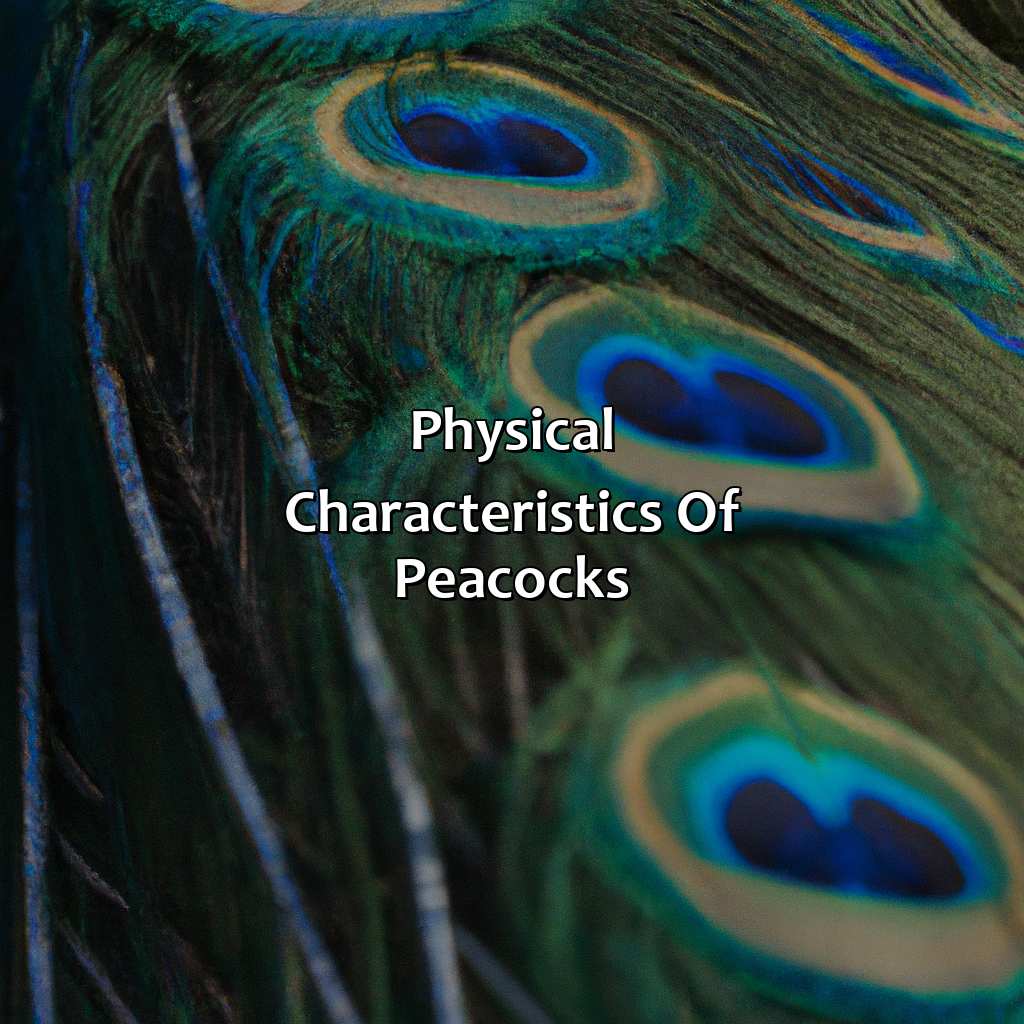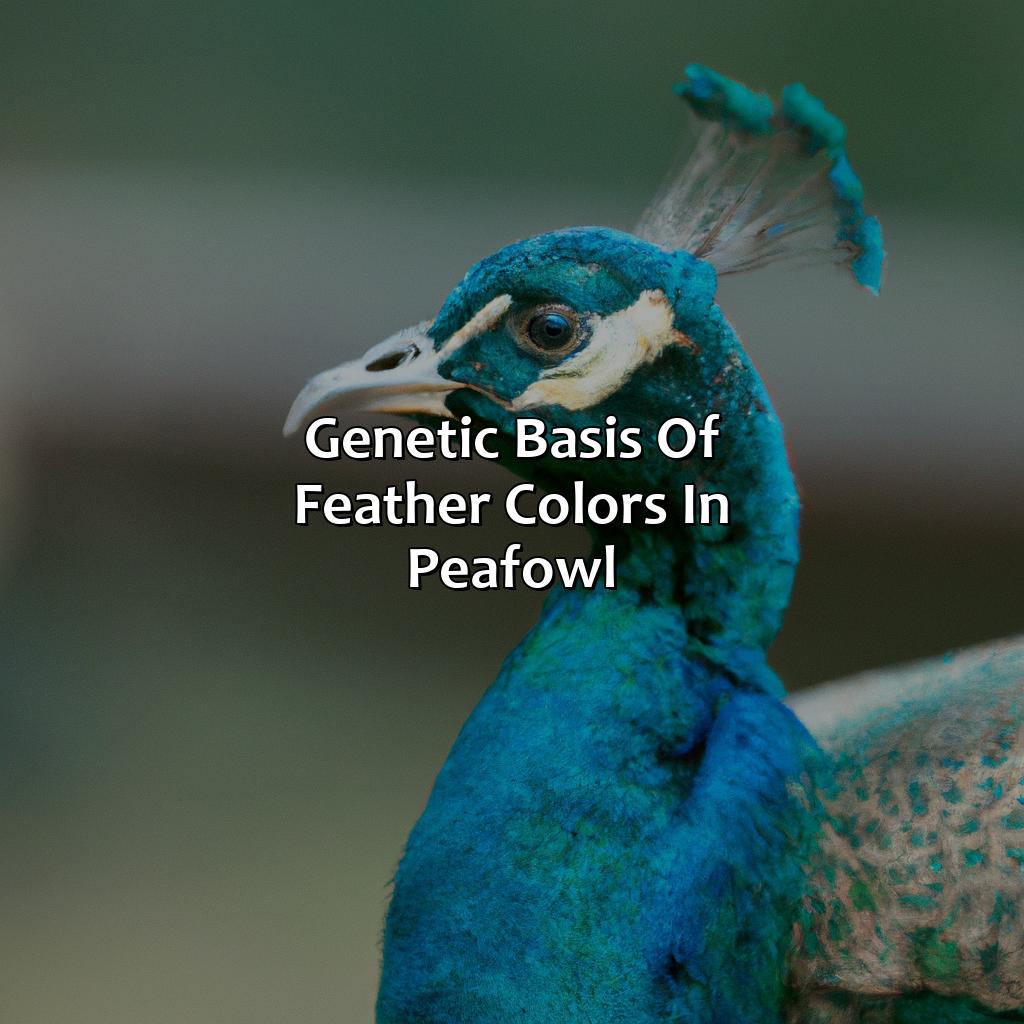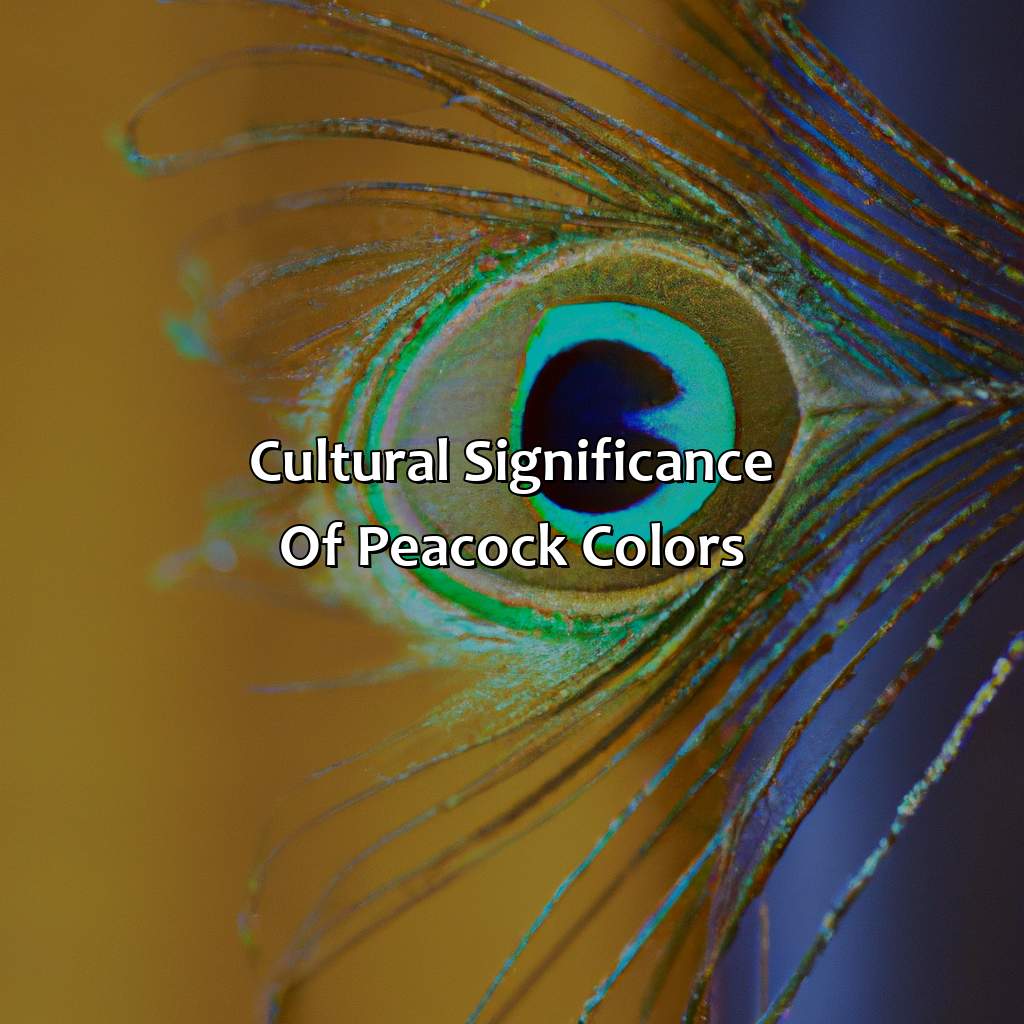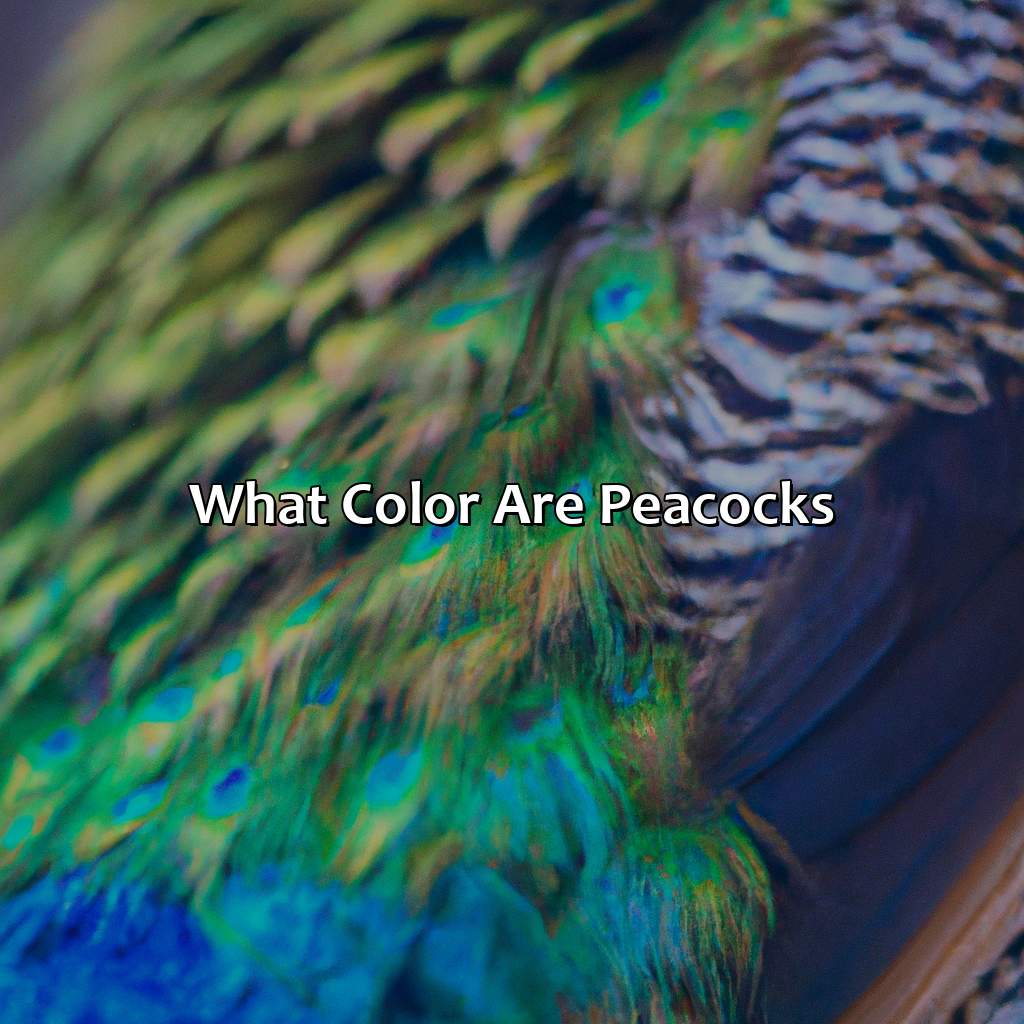Key Takeaway:
- Peacock feathers are known for their ornamental value and are primarily associated with the male peafowl. The iridescent colors of peacock feathers are a result of the reflection and diffraction of light on the feathers, which creates a stunning metallic hue and intricate patterns.
- Male peafowl have vibrant and exotic feathers that display a range of blue and green colors. Their tail feathers are particularly striking and are used in courtship displays to attract females. On the other hand, female peafowl have less vibrant feathers that are used for camouflaging and blending into their environment.
- The genetic basis of feather colors in peafowl involves a complex interplay between melanin and carotenoids, which are influenced by environmental factors such as diet and habitat. Research on the genetics of feather coloration in peafowl has important implications for conservation efforts and wildlife management.
Physical Characteristics of Peacocks

Photo Credits: colorscombo.com by Christopher Lewis
Peacocks have amazing physical characteristics that can be seen in their feathers. These feathers have iridescent blues, greens, and metallics that create spectacular patterns.
Learn about the vibrant colors of both the male and female peafowl. The male’s tail is particularly majestic, with its dazzling array of colors. It’s simply gorgeous!
Feather Colors of Male Peafowl
Male Peafowl Coloration – A Brief Study on Iridescence and Patterns
The male peafowl is known for its iridescent and eye-catching plumage. These colors are essential for courtship, with males attracting females through their vibrant displays. The feather colors of male peafowl are diverse and remarkable.
- Peacock feathers exhibit a range of hues including blue, green, purple, gold, and bronze.
- The feathers are adorned with complex patterns consisting of ocelli or ‘eyes’ resembling a blur or shape of a human eye.
- Eye-spots can occur in different sizes and shapes depending on the species.
- After molting, males grow their new long tail feathers during the breeding season (usually Spring), which they fan out to showcase their beauty for potential mates.
It is said that the patterns and shapes on peacock tails provide healthy reproductive information to females about the males’ immunity status. However, these evolutionary theories still remain under debate in scientific communities.
Who said women can’t have colorful and impressive feathers? Female peafowl beg to differ with their beautiful iridescence and unique feather patterns.
Feather Colors of Female Peafowl
Female peafowl are not as brightly colored as males, but they possess unique and subtle hues that play an important role in their survival and reproduction.
- The feather colors of female peafowl exhibit more browns and grays than males.
- Their feathers display iridescence which helps them blend into their surroundings and avoid predators.
- The color patterns on female peafowl’s feathers are less elaborate than those of males, with horizontal stripes being the most common pattern.
- Female peafowl’s feather colors vary depending on their age, health and reproductive status.
Pro Tip: When observing female peafowl, it is essential to look for the subtle shades in their feathers rather than expecting a flamboyant display like that of males.
Why settle for a regular bird when you can have a genetically diverse and stunningly colorful peafowl?
Genetic Basis of Feather Colors in Peafowl

Photo Credits: colorscombo.com by Christian Harris
Uncover the genetic basis of peafowl feather colours. Investigate the role of melanin and carotenoids. Explore expression and inheritance patterns of genes. Understand how genetics, evolution and environment interact with feather colours. With this knowledge, we can support conservation, protection and education of these endangered birds.
Role of Melanin and Carotenoids
Pigment enzymes are essential for producing melanin, which gives a range of black, gray, and dark brown colors to the feathers of peafowl. In contrast, carotenoids, which are absorbed from their diet, give rise to a variety of hues such as yellows, oranges and reds. The interplay between these two pigments determines the specific feather coloration in peafowl. Gene expression is tightly regulated by highly coordinated biochemical pathways for synthesis and deposition of pigments into feathers.
The combination of melanin and carotenoids pigments determine the various exquisite hues seen within Peacock plumage. Genetic variation exists across geographically isolated populations and even among individuals with a given population due to environmental factors that alter pigment synthesis or existent mutations in regulatory genes that promote different patterns or amounts of pigment deposition. Hence each bird has its unique pattern of feather pigmentation despite living in the same flock.
Peacock feathers have cultural significance worldwide as symbols of beauty, integrity, royalty or holiness. In Indian culture specifically they also have religious significance related to gods such as Brahma who is depicted with an elaborate headdress made up of peacock feathers. On fashion runways globally today it’s continuing popularity renewed every season. Designers embrace these magnificent hues for products like their high-end handbags for many luxury brands though they don’t pattern after the feather designs directly.
Of note is their iridescence produces an optical effect because structure selectively reflects wavelengths (structural coloration). Due to this effect, the eyes who observe the beautiful display see a luminous spectacle that continually changes depending on light sources surrounding them at any given moment creating almost like a small iridescent rainbow around male Peafowls during displays.
Peacock feather colors are determined by genetics, proving that even in the animal kingdom, family drama is responsible for our fashion choices.
Gene Expression and Inheritance Patterns
Peacock feather colors are determined by the gene expression and inheritance patterns of melanin and carotenoids. Melanin regulates the dark colors of the feathers, while carotenoids determine the bright hues. The genes involved in this process follow a Mendelian pattern of inheritance, with dominant and recessive alleles affecting how much color is expressed. Peacocks inherit their coloration from their parents, and variations can occur due to random mutations or environmental factors.
Interestingly, some peafowl species have different inheritance patterns for male and female feather colors. For example, in the green peafowl species, males express a unique iridescent blue-green coloration not found in females. This is due to sex-linked genes that are only expressed in one gender or the other.
It’s worth noting that not all peafowl with vibrant feathers are genetically healthy – breeders often selectively breed for more colorful birds, leading to health problems such as weakened immune systems and poor vision. It’s important to prioritize animal welfare over aesthetics when choosing which birds to breed or showcase.
Why settle for a boring outfit when you can just wear peacock feathers and let everyone know you’re fabulous?
Cultural Significance of Peacock Colors

Photo Credits: colorscombo.com by Sean Young
Grasp the cultural importance of peacock colors by exploring the symbolic and symbolic meaning between varied cultures. If you’re fascinated by fashion and design, uncover the utilization of these colors in style and design.
Symbolism and Meanings Across Different Cultures
Colors of peacocks have been symbolic and meaningful in different cultures throughout history. The feathers have represented pride, power, and beauty for centuries, with many myths and legends surrounding their origin and significance.
In Hinduism, the peacock is associated with the goddess Lakshmi, representing royalty, fertility, and good luck. In Greek mythology, Hera chose a watchful peacock as her sacred bird, symbolizing wisdom and protection. Similarly, in Chinese culture, peacocks are revered because they are thought to be able to ward off evil spirits.
The colors of the male peacocks’ feathers are particularly significant in various cultures. For instance, in some Native American tribes of North America where the bird is native to include white feathers on a fan of a male adult signify purity or vision while blue or green would suggest healing or harmony respectively. Different meanings are also attached to specific feather colors; for example, blue stands for heaven while green represents earthy nature in China.
Peacock colors have inspired many fashion designers around the world for their unique patterns that can be incorporated into clothing designs and accessories such as scarves or bags. Popular shades such as cobalt blue or emerald green are used to create luxurious items combining practicality with extravagance.
To get creative with color matching in several sectors like fashion designing or creating home décor items checking out various cultures’ uses of peacock color schemes could prove beneficial. Additionally, incorporating color psychology principles such as using bold hues together represent confident assertiveness may elevate one’s brand identity if appropriately executed.
Peacock colors are so stylish, even fashion designers can’t resist their vibrant charm.
Use of Peacock Colors in Fashion and Design
The rich and vibrant colors of peacock feathers have been a source of inspiration for fashion designers and artists alike. These colors, especially the iridescent greens and blues, are often used to create stunning pieces in fashion and design. Fashion designers use peacock colors to add vividness and depth to their creations, making them stand out. Peacock colors are also used in interior design, where bright accents using peacock colors bring a touch of elegance and style to any space.
One can also use textures mimicking the patterns found in peacock feathers, which adds a layer of complexity to designs. The unique color combinations found in male and female peafowls’ feathers inspire various collections throughout the fashion industry. Their grace is also portrayed through fabrics such as silk or chiffon that take on the fluid movement of these birds’ feathers.
Adding a personal touch by experimenting with distinct hues while keeping the option natural-looking helps make any design incorporating such colors fresh and exquisite. Designs featuring these shades are sure to make an everlasting impression.
Pro Tip: Don’t be afraid to mix different shades of peacock-inspired tones together when designing outfits or interiors; experimentation can lead to unexpected yet striking combinations!
Five Facts About Peacock Colors:
- ✅ Male peacocks have iridescent blue-green feathers on their necks and bright blue feathers on their bodies. (Source: National Geographic)
- ✅ Female peacocks, called peahens, are less colorful than males and have predominantly brown feathers. (Source: Britannica)
- ✅ The bright colors of male peacocks are used to attract mates during courtship displays. (Source: Audubon)
- ✅ Peacock feathers are made up of tiny structures that reflect light, creating the eye-like patterns on their feathers. (Source: Science Daily)
- ✅ Peacocks are not born with their colorful feathers; they grow them over time through a process called molting. (Source: Live Science)
FAQs about What Color Are Peacocks
What color are peacocks?
Answer: Peacocks are known for their vibrant and colorful feathers, which are predominantly blue and green. The male peacock, also called a peafowl, has a bright blue body and a tail featuring iridescent green, blue, and gold hues, while the female’s feathers are brown and grey for camouflage.
Do all peacocks have the same color feathers?
Answer: While blue and green are the most common colors seen in peacock feathers, not all peafowl have the same colored feathers. Different breeds of peafowl can display different color variations and patterns in their feathers, such as white, pied, and black.
Can the color of peacock feathers change?
Answer: The color of peacock feathers does not change, but the iridescence and brightness can appear to vary depending on the lighting. The feathers’ reflective surfaces, which produce their distinctive colors, can appear darker or lighter depending on the angle and quality of light.
Are all peacock feathers naturally bright and colorful?
Answer: Yes, peacock feathers naturally have bright and colorful hues. The feathers’ iridescence comes from tiny, crystal-like structures on each feather’s surface that scatter light in a way that creates a shimmering effect.
Why do peacocks have such colorful feathers?
Answer: Male peacocks have colorful feathers to attract female peahens during mating season. The vibrant feathers are a way for the males to display their physical fitness and genetic quality to potential mates.
Do peacock feathers have any symbolic meaning?
Answer: Peacock feathers have been seen as symbols of beauty, wealth, and good luck in various cultures throughout history. In Hinduism, for example, the peacock is associated with the god of wisdom, and peacock feathers are often used in religious rituals.





